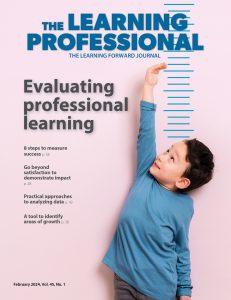By Bonnie Hain and Jim Mirabelli
Throughout the teaching-learning process, successful students and their teachers set clear learning goals and monitor progress to meet those goals. As teachers learn their students’ strengths and needs in relation to learning goals, they can change instruction and practice to acquire deeper knowledge and understandings, ultimately increasing student achievement. This ongoing practice of assessment is therefore a critical component of instruction. When we use the data from well-designed assessments, we are best able to chart an effective teaching and learning path. In contrast, poorly designed assessments can lead to miscues in student learning needs and corresponding inefficiencies in mapping next-steps instruction for successful attainment of learning. What steps can educators take to improve the quality of data available to them to support teaching and learning goals?
Analyze State Test Development Guidelines
One critical means to this end is to develop a deeper understanding of the criteria for high-quality assessments, allowing educators to better select items and tasks from those provided in curricula and textbooks that best align with learning targets. A number of resources are available to help clarify these criteria. For example, educators can look at the test specifications for their state assessment and review patterns for wording in released items. States today have stringent requirements for test makers to develop clearly worded items that are well-aligned to state standards. Teachers should look beyond the glitz and glamour of the technology-enhanced item types and instead identify the overlap between the words of the specifications and released items and the words in the standards. The “overlap” is the pattern that can help educators select the quality items from any locally provided item banks.
Use Evidence-Centered Design Principles in Classroom Assessment
Another means is to learn more about Evidence-Centered Design (ECD) and to apply these principles to creating classroom formative assessment tasks aligned to college- and career-ready standards. In ECD, one begins with the end in mind by putting in writing the specific claims one wants to make regarding student knowledge and skills. For example, if you were teaching someone all the skills needed to swim the butterfly, you might put down as a claim for an aligned assessment that “the student will swim butterfly independently for 50 yards.” (In ELA classes, it’s typical to claim that “students will read and comprehend grade-level literary and informational texts.”) Next up is to write down the evidence statements that could support that claim—bullets that describe what it looks like, sounds like, etc. when a student has really met the claim. In our swim example, I might list the following evidence statements:
- The student’s arms and legs move in the patterns expected for butterfly to propel the student through the water.
- The student controls his/her breath effectively to allow for the student to move through the water and down the lane of the pool for 50 yards.
For the ELA claim, we might see evidences such as:
- The student provides a complete summary of the text, including the most important details from the beginning, middle, and end of the text.
- The student describes the relationship between two events in a provided text and uses details from both texts to support the description provided.
Once we have identified the claims and evidences, then it’s time to create the formative task. The task needs a response mode (will the student write a blog? compose a song? create a poster?) an audience (for the teacher? for himself/herself? for a community member?), and basic logistics (due date? expected length? other criteria?).
In the case of our swim example, the obvious response mode is “a swim.” The task might look something like: “It’s time to show how well you can do the butterfly. Get into the pool and swim the full length of the pool and back (for a total of 50 yards). Remember to use the arm and leg movements we have practiced and the breathing techniques taught. I and the other instructors will be watching to see how much you have learned. You have five minutes to complete the swim.”
For the ELA example, the task might say something like: “We have read and summarized several articles about the effect of the moon on the tides together. Now, read ’The role of the tides’ and write a summary of this article. You will share this summary with the class in a two-minute presentation.”
Putting it all Together
As you can see, Evidence-Centered Design leads us to envision student learning and create formative tasks that logically and clearly connect our learning targets with the student work to be analyzed. When students respond to assessments designed using ECD, we can collect great information on what students know and can do and what additional steps may be needed for students to meet expectations.
And this, after all, is the ultimate value of diving in deeper to develop our own assessment literacy as teachers—since well-designed assessments give us the information we need to meet our students’ needs. With quality assessments, we have confidence that the judgements we are making about next steps instruction (whether we need to go back and reteach struggling students or to move ahead and extend learning for others) are truly in our student’s best interests.
For more information on selecting high quality items/tasks from item banks and using ECD, join Bonnie A. Hain and Jim Mirabelli in Portland, Oregon, on July 19-22, 2018.
About the authors
 Bonnie Hain is the chief of academics and district services at CenterPoint Education Solutions. She has over 25 years of experience in the field of education as a teacher, administrator, and researcher. She began her career as a teacher of world languages and English language arts in grades 7-12, then spent seven years as a full-time college professor of English and English Education. She has also held positions as a reading coach, building administrator for both elementary and middle schools, district curriculum specialist, and English language arts specialist for the Maryland State Department of Education. Hain served as a director of curriculum for a large urban district before joining Achieve to help design the Partnership for Assessment of College and Careers (PARCC) English language arts/literacy assessment.
Bonnie Hain is the chief of academics and district services at CenterPoint Education Solutions. She has over 25 years of experience in the field of education as a teacher, administrator, and researcher. She began her career as a teacher of world languages and English language arts in grades 7-12, then spent seven years as a full-time college professor of English and English Education. She has also held positions as a reading coach, building administrator for both elementary and middle schools, district curriculum specialist, and English language arts specialist for the Maryland State Department of Education. Hain served as a director of curriculum for a large urban district before joining Achieve to help design the Partnership for Assessment of College and Careers (PARCC) English language arts/literacy assessment.
 Jim Mirabelli is the director of STEM assessment design and development at CenterPoint Education Solutions. Mirabelli began his career in the classroom, teaching high school mathematics for ten years. He also served as a mathematics assessment specialist for the Indiana Department of Education for nearly eight years. Prior to joining CenterPoint, Mirabelli was a senior program associate for mathematics at Parcc Inc. where he worked on the design and development of the PARCC mathematics assessment.
Jim Mirabelli is the director of STEM assessment design and development at CenterPoint Education Solutions. Mirabelli began his career in the classroom, teaching high school mathematics for ten years. He also served as a mathematics assessment specialist for the Indiana Department of Education for nearly eight years. Prior to joining CenterPoint, Mirabelli was a senior program associate for mathematics at Parcc Inc. where he worked on the design and development of the PARCC mathematics assessment.








